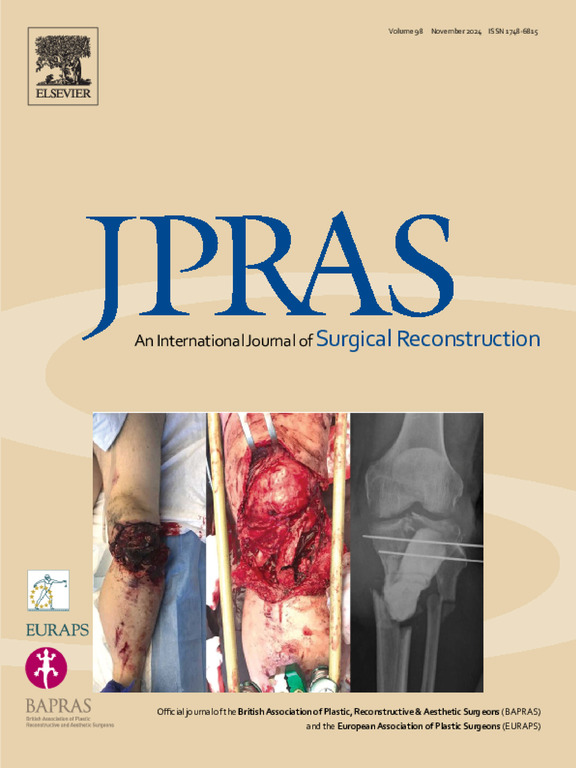唇裂患者继发性唇部畸形的翻修手术率:一项系统综述
IF 2.4
3区 医学
Q2 SURGERY
Journal of Plastic Reconstructive and Aesthetic Surgery
Pub Date : 2025-07-04
DOI:10.1016/j.bjps.2025.06.016
引用次数: 0
摘要
初次唇裂修复后的继发畸形需要不同程度的手术干预,从轻微的疤痕修复到完全取下和修复。翻修手术本身可能需要多种干预措施,这对患者和卫生系统都是相当大的负担。在本研究中,我们评估了文献中报道的唇部继发性畸形的翻修手术率。方法按照PRISMA标准进行系统评价。使用Pubmed、SCOPUS和Cochrane数据库。研究报告了唇部整形手术的发生率。非英语的非唇裂患者的研究,或在两个不同的机构进行了初级和翻修手术的研究被排除在外。结果共纳入34项研究。总体修正率为21.2±14.6%(范围:0-91.2%)。按表型分层,单侧唇裂翻修率为32.3±18.9%,单侧唇裂为78.6±6.5%,单侧唇裂为29.6±24.4%,双侧唇裂为36.7±21.6%。表型组间无显著差异。术前矫形组和未术前矫形组的矫正率无显著差异(16.6±13.6%)(25.3±9.5%)(p=0.06)。在手术技术方面,旋转推进矫正率为27.3±19.0%,直线修复率为12.0±22.4%,解剖亚单位近似矫正率为8.1±0.5% (p=0.63)。最常见的手术指征是疤痕修复(26.2%)。结论目前文献报道的翻修手术率差异很大。二次手术最常见的适应症是疤痕修复。改进手术技术的报告是必要的,以指导基于证据的初级唇部修复方案。本文章由计算机程序翻译,如有差异,请以英文原文为准。
The rate of revision surgery for secondary deformities of the lip in cleft lip patients: A systematic review
Introduction
Secondary deformities following primary cleft lip repair require varying degrees of surgical intervention, from minor scar revision to complete takedown and repair. Revision surgery can itself necessitate multiple interventions, representing a considerable burden for both patients and the health system. In this study, we evaluate the reported rates of revision surgery for secondary deformities of the lip within the literature.
Methods
A systematic review was conducted following PRISMA criteria. Pubmed, SCOPUS, and Cochrane databases were utilized. Studies reporting rates of lip revision surgery were included. Studies with non-cleft patients, not in English, or those with primary and revision surgery at two different institutions were excluded.
Results
Thirty-four studies were included. The overall revision rate was 21.2±14.6% (Range: 0–91.2%). Stratified by phenotype, revision rates were 32.3±18.9% for isolated unilateral cleft lip, 78.6±6.5% for isolated bilateral cleft lip, 29.6±24.4% for unilateral cleft lip and palate, and 36.7±21.6% for bilateral cleft lip and palate. No significant differences were found between phenotypic groups. Revision rates did not significantly differ between studies that used presurgical orthopedics (16.6±13.6%) and those that did not (25.3±9.5%) (p=0.06). With regards to surgical technique, revision rates were 27.3±19.0% for rotation advancement, 12.0±22.4% for straight line repair, and 8.1±0.5% for anatomic subunit approximation (p=0.63). The most common surgical indication was scar revision (26.2%).
Conclusion
Current literature reports a wide range of rates for revision surgery. The most common indication for secondary surgery is scar revision. Improved reporting of surgical technique is necessary to guide evidence-based protocols for primary lip repair.
求助全文
通过发布文献求助,成功后即可免费获取论文全文。
去求助
来源期刊
CiteScore
3.10
自引率
11.10%
发文量
578
审稿时长
3.5 months
期刊介绍:
JPRAS An International Journal of Surgical Reconstruction is one of the world''s leading international journals, covering all the reconstructive and aesthetic aspects of plastic surgery.
The journal presents the latest surgical procedures with audit and outcome studies of new and established techniques in plastic surgery including: cleft lip and palate and other heads and neck surgery, hand surgery, lower limb trauma, burns, skin cancer, breast surgery and aesthetic surgery.

 求助内容:
求助内容: 应助结果提醒方式:
应助结果提醒方式:


